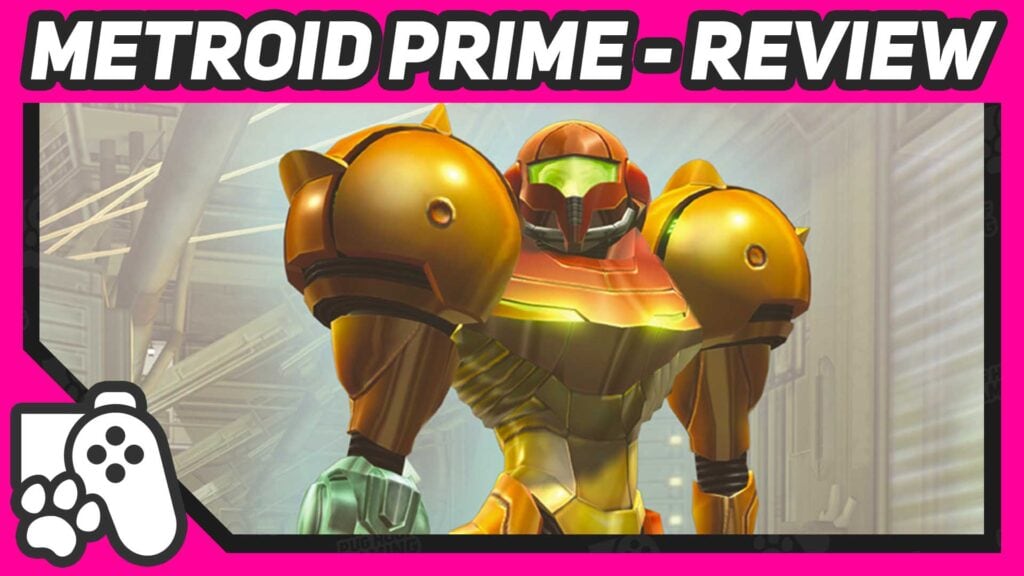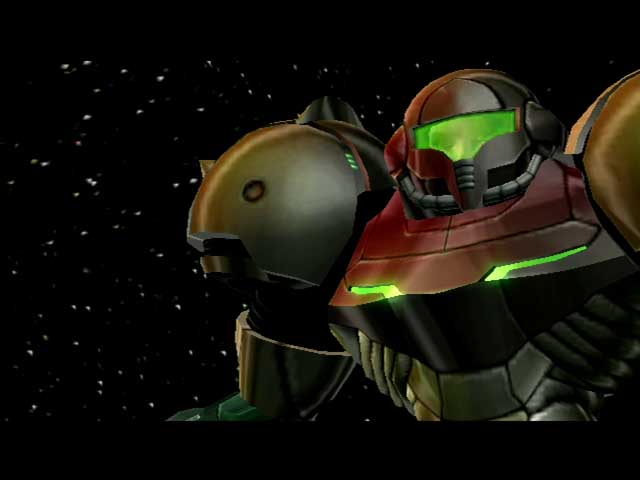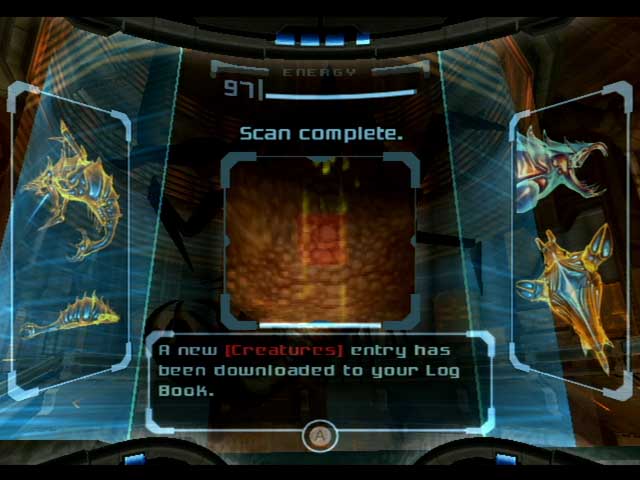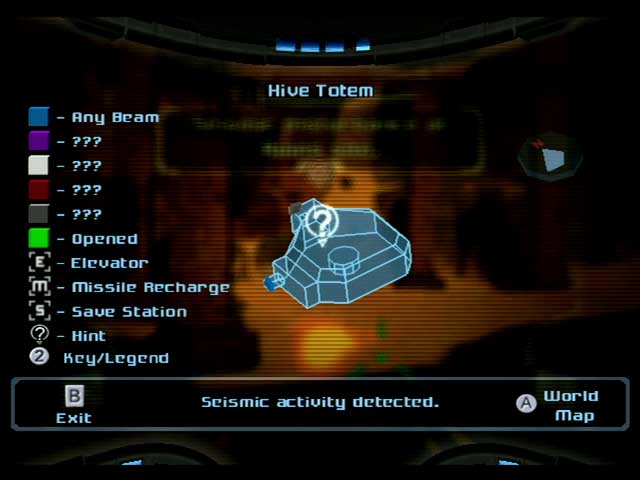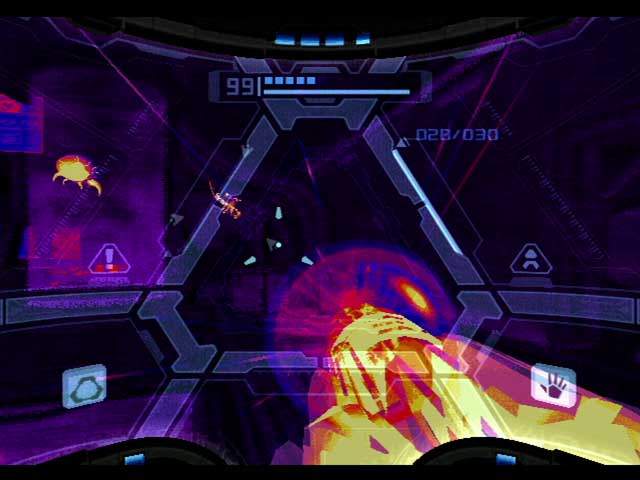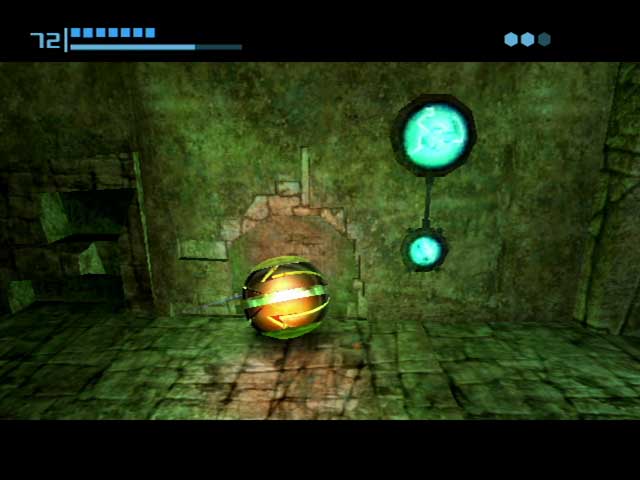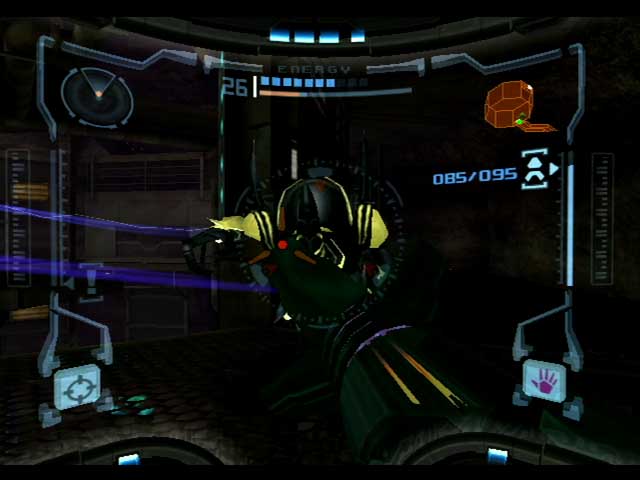As previously mentioned in my Metroid Fusion review, fans were hard done by in the years between Super Metroid and the double-whammy of Metroids Fusion and Prime. Nintendo didn’t have the confidence of delivering a 3D Metroid game, ensuring that Samus’ only N64 appearance was as a competitor in Super Smash Bros. When it turned out that the series would finally make its 3D debut on the Gamecube console, in a game jointly created by Nintendo and a newly-formed Western third-party by the name of Retro Studios; it was hard to know what to think.
During a visit to the studio in 2000, Shigeru Miyamoto himself saw what Retro was doing with their prototype for a first-person shooter, and suggested they could make a new Metroid with it. Over the next couple of years, Retro Studios cancelled the four games they had been working on in development, to focus solely on bringing Samus Aran to the Gamecube. The result is a game that I don’t think Nintendo could have made themselves at the time, but their presence and oversight are definitely clear to see.
Metroid Prime Review – Intro
Chronologically speaking, Metroid Prime doesn’t follow on from previous titles, slotting itself after the original Metroid. Following the destruction of Zebes, the Space Pirates are still a presence in the galaxy. The playable prologue starts with Samus responding to a distress signal from a Space Pirate research station called the Orpheus, that’s orbiting the planet Tallon IV. On this frigate, some nasty experiments are taking place involving a newly-discovered substance called Phazon. The player soon shuts this facility down in explosive style, but not before a newly-revived form of Samus’ nemesis, Ridley, flies off to the nearby planet, with our hero closely following. What follows is a new adventure that delves more into Chozo lore and their legacy, the origins of Phazon, and another Space Pirate scheme to be quashed. You start this prologue with a pretty powered up Varia Suit version of Samus, giving you a taste of the strength of Samus at her most tooled up, but not before the game strips you of this power very quickly and leaves you with a very weedy-looking Power Suit.
Common sense would have made most developers slot Metroid into a third-person genre and call it a day, but to put players in the perspective of Samus herself, was arguably a very bold move. Prime may have a first-person camera, but the unique lock-on based control scheme definitely pushes the game away from being a first-person shooter as we know it. How this new perspective plays is very much a matter of whether you are playing the original Gamecube version, or the Wii remote-enabled Metroid Prime Trilogy version, but I’ll talk a little about the differences a little later. All you need to know is that Prime goes above and beyond many first-person games by making it very clear you are looking out of Samus’ eyes, through her helmet visor, with all the pros and cons that might apply. Walk past broken steam pipes and the visor will briefly mist up. In certain areas with a light source, you can see Samus’ face reflected in the visor. Samus will encounter various visor modes that will add a scan function, thermal imaging and X-Ray vision to aid in certain scenarios. These alternate views have genuine uses and what’s more, are abilities that have extensive use throughout the entirety of the game. The attention to detail put into how the first person view fits in with Samus’ suit and abilities is a feat that I don’t think anyone has significantly tried to replicate, and I want to know why the Hell not?
In fact, you can see that Retro Studios tried to put a great deal of attention to detail in everything. The scan visor is a great example of this – This visor ability allows Samus to interact with terminals to activate lifts and other things, scan creatures to add them to the Logbook and find weak points, scan panels and terminals to obtain background info on the Chozo and the Space Pirates respectively, and even find a great deal of optional information that helps bring this world to life. Prime keeps track of your Logbook completion percentage, and while annoyingly there are a few missable items that if you don’t scan them once they appear, you’ll never see them and have to start a new game again, the Scan visor is an essential part of the game that works very well. I especially like the fact that it can be used to scan areas that can be damaged with particular weapons to find hidden items and areas – Cleverly, the game tells you what material these areas of interest are made of, which after a while, you start to figure out what materials can be damaged with what item – A useful piece of information if you’re paying attention.
Metroid Prime takes place on the planet of Tallon IV, which is split into six distinct areas, all interlinked at various points. Tallon Overworld is where Samus lands her ship initially, a leafy region full of indigenous life of all types. Chozo Ruins is an archaic series of interior and exterior ruins that help fill out the Chozo race’s background for the first time in the series. Here, Samus begins to realise her role is part of a Chozo prophecy to collect 12 artefacts that open the seal to the impact crater that brought Phazon to this planet. Magmoor Caverns is your typical Hell-like fire cavern where you can expect hot, hot heat and some nasty lava-dwelling foes. Phendrana Drifts is an arctic wasteland that is also home to a Space Pirate research base, filled with useful tech and deadly enemies. The Phazon Mines is the base of the Space Pirate’s Phazon-mining operation, littered with some of the nastiest soldiers the pirate crew have to offer. After collecting all of the game’s artefacts and coming face to face with a familiar foe, Samus can then reach the final area – The Impact Crater.
Naturally, this is a Metroid game and not all areas can be explored from the beginning, so you can bet your bottom dollar you’ll need to find plenty of upgrades and abilities to push you further into each nook and cranny of Tallon IV. A fully zoomable and rotatable 3D map opened by pressing the Z button does a great job of ensuring you’re not too lost, and a completely optional hint system is enabled from default. This welcome feature gives you a fair amount of exploration time before nudging you roughly in the right direction to the next required item. Because it can be turned off, Prime instantly gives Metroid players of all abilities and preferences to play how they want – It’s truly the best of all worlds, which will please those who found Metroid Fusion a little too handhold-y, while players new to the series are definitely catered for. Upgrades and pickups are no longer marked on the map, but they do give off a very distinctive sound that can be used to pinpoint their location, but sadly there is no way in-game to keep track of the pickups you have found, apart from Logbook entries and Chozo Artifacts.
For those who love atmosphere, Prime absolutely has you covered. Setting the game in a first-person viewpoint brings a sense of discovery unlike any prior game in the series, with the game’s audio doing a wonderful job in bringing you to this brand new set of environments to navigate. Some classic tracks from Super Metroid are brought back in new arrangements, alongside all-new tracks that fit wonderfully with the setting, and overall the audio design is top-notch and really brings an otherworldly feeling throughout the entirety of the game. Criticism could be made at its very early 2000’s approach to graphics, with a very dark, palette that feels a bit lifeless – But the way those classic sprites have been moved to the 3D space is nothing short of impressive.
Combat-wise, it’s incredibly unique. In its initial Gamecube form, the left stick is used for movement and is used for free-looking when the R button is held. Pressing L locks on to the nearest enemy in range of the reticle, which is the standard method of tackling enemies. The giant A button fires, B jumps, Y fires missiles and X triggers the Morph Ball mode once found, whilst the Dpad and yellow C stick are used to select between the four different visor modes and four different types of beam weapon, respectively. Meanwhile, the Wii version has similar controls mapped to the Wii remote and nunchuck, but the player can also use the remote to aim their fire, even when locked on. Once you get used to only using the one analog stick, the original Gamecube controls are more than suitable for the game, but there is something to be said for the freedom the Wii controls give you, especially when dealing with multiple enemies at once. However, with this method, you have to move the pointer to the edges of the screen to turn around, which can be a little fiddly and cumbersome.
Throughout Prime, there are several mini-bosses and regular bosses, and admittedly the majority of bosses, despite their ginormous size, are relatively easy to destroy. With the game’s logbook scans more or less telling you how to defeat each enemy, these fights aren’t going to give you too much trouble, provided you’ve got enough energy and missile tanks. These segments are arguably the weakest part of Metroid Prime and have aged quite poorly. Another slightly annoying aspect can be the occasional foray into platforming, which, in a first-person shooter can be very annoying. The Gamecube version tries to mitigate this annoyance by moving the view slightly downwards when jumping, something that the player has to do manually in the Wii version. Sadly, it doesn’t quite work well, and there are quite a few moments when an enemy attacks you and knocks you off a platform, meaning you usually need to climb all the way back up again. There are a few platforms late in the game that are invisible and require you to view them using the X-Ray visor, which also severely reduces your range of vision, potentially causing more mishaps when enemies attack from seemingly nowhere.
Ultimately, you need to remember that Metroid Prime is not a first-person shooter. It’s a slower, more deliberately paced game than you’d expect. It’s not about speeding around platforms, blasting Space Pirates left and right. Retro Studios give you ample time to breathe, to take in the sights and sounds of Tallon IV, ample time to explore at your leisure and open up every single crevice of this world. Even when multiple enemies have you in their sights, you rarely feel overwhelmed with no time to think about your next move. So long as you can lock on to an enemy and sidestep using the jump button, you can give yourself time to regroup and figure out how to take this foe down. This is a game to be enjoyed, at your leisure, and no bigger proof of this is how it approaches its end. Most Metroid games intend for you to finish the game as quickly as possible to get a better ending – Not Metroid Prime; here, it’s all about getting 100% of items. Thankfully, logbooks do not count in this percentage.
Once you’ve read this Metroid Prime review, and you’re looking to play the game today, there are multiple versions and even incremental revisions – There’s the original Gamecube version of course, but the original American and Japanese versions had a few bugs which were resolved in the PAL release, which also changed a few things such as logbook locations and text. Then, there’s the Wii version either as the Japanese New Play Control version or as part of the Western Metroid Prime Trilogy collection. This is the version I’ve been playing for this review, which adopts most of the changes implemented in the PAL versions of the game. Annoyingly, I wish there was support for the Pro Controller to allow for a more traditional control scheme to keep things close to the original Gamecube version, as I did find myself struggling with the motion controls way too many times than I would have liked. I did spend a couple of hours playing the Gamecube version too, and I must admit there’s pros and cons to both versions, especially in terms of controls. It’s worth noting that the Metroid Prime Trilogy version is an easier game, with the Veteran difficulty being closer to the Gamecube’s difficulty. Plus, the Morph Ball now has a jump function by shaking the Wii Remote, which does make some puzzles a bit easier.
In addition, the original Gamecube version had a neat link-up feature with Metroid Fusion for the GBA. Using the GBA to Gamecube link cable, if you complete Metroid Fusion and link the game up to Metroid Prime, you can unlock a port of the original NES Metroid (complete with an actual save feature), and you can also unlock the Fusion suit in Metroid Prime, which can be used once you’ve finished the game once. The Fusion suit doesn’t really do anything special, and you only rarely see Samus during the occasional cutscene so it’s more of a neat bonus than anything else. Metroid Prime Trilogy doesn’t have any connectivity with the GBA, but it does have the addition of achievements, new to this version and unlocked by completing your logbook, defeating bosses and finding all of the game’s artefacts.
I haven’t played Metroid Prime since the mid-2000s, and back then I didn’t feel as enamoured with it as I did the 2D Metroid games. Here and now, in 2021, I think I finally “get it”. Retro Studios took a great deal of inspiration from Super Metroid, placed their take on the series in a very unique 3D viewpoint, with mechanics to match, and surrounded it with a great deal of effort and detail. The graphics might look dated today, but the gameplay mostly feels as fresh as ever – This is absolutely one of the best Metroid games ever made, and one of the best games on the GameCube, for sure. You can’t help but be impressed – Nintendo took a huge risk with trusting one of their big franchises with a Western developer, but it absolutely paid off here. Without a doubt, it is a worthy take on a beloved series, that would define and shape it for years to come.
Following this Metroid Prime review, The Road To Dread continues, but rather than go forward on this road, we go back in time with Metroid: Zero Mission, Nintendo’s own attempt at remaking the original Metroid. Come back soon for a full review on this second GBA Metroid title!
